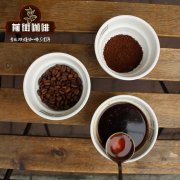Guatemala Pinnacle Coffee Manor introduction is the coffee bitter in Guatemala Pinnacle Manor?

Professional coffee knowledge exchange more coffee bean information please follow the coffee workshop (Wechat official account cafe_style)
Farm: Finca La Cumbre
Variety: 100% Catuai
Processing: fully clean and sun-dry the patio
Altitude: 1675-1825 m above sea level
Owner: Federico Cruz Sandoval
Town / city: San Katarina Pimra and San Jose Pimra
Region: Fraijanes
Finca La Cumbre is located on the periphery of the bustling city of Guatemala City, just south of the city. In fact, it is unusual for a 40-hectare farm to be so close to the urban boundary. Most of the farms in this area are small-an average of only 2 to 4 hectares-because the demand for land in the area is very high.
Federick Cruz Sandowal, the current owner of La Cumbre, spent his summer vacation on his grandfather's farm and played in the fields when he was very young. Just then, he fell in love with agriculture and coffee. He studied agronomy at school, worked as an agricultural technician for many years, and reached a high level in his field. In fact, from 1959 to 1964, he even worked for the International Coffee Organization in Guatemala. However, although he has lived in the countryside for many years, he has not been responsible for his land for many years. When he retired in 1990, he decided it was time for him to devote his time to his farm. He bought La Cumbre and started growing coffee, mainly out of a love of agriculture and selling his harvest locally. However, this is more about market access than product quality. From 2016 to 2017, he will harvest "specialty" coffee for the first time.
When Don Federico bought the farm, it was called "Old Benitez"-simply named after its former owner. But he doesn't think it captures people's imagination. Because the farm is located in the highest part of the area, he chose "La Cumbre"-"Peak". The name not only conveys a sense of locality, but also describes the coffee quality of Don Federico!
The coffee in La Cumbre is carefully cared for, as you might expect from such an experienced agronomist. But it is important to remember that for Don Federico, the love of the land is as important as the love of coffee. The farm is not organically certified, but they make every effort to limit the use of pesticides on the land. They also farm on the contours to prevent soil erosion. As a forest reserve, most of the farms are also fallow. There is also a small herd of cows on the farm who eat more grass than produce milk and about 600 Haas alligator pear trees. But coffee is the only economic activity on the farm. In the words of Don Ricardo, "avocados are usually eaten by squirrels."
Due to high altitude and cool climate, almost 100% of the Catuai plants on the farm are relatively protected from coffee leaf rust. Nevertheless, frequent use of primary and secondary elements as well as organic fertilizers are essential to maintain peak yields. It is renovated every year. Shade control makes it possible to avoid the use of herbicides, and insects are not a current problem. Although the average age of trees is 25 to 30 years old, these plants are healthy, happy and produce high-quality cherries. Still, Don Federico (Don Federico) always looks forward, noticing that in some parts of the farm, other varieties may be more adaptable to the climate. He is currently experimenting with Villa Sarchi and Obata in some parts of the farm.
Although La Cambre is located in a densely populated area, it may be difficult to find workers. Most people in the area find it easier and more profitable to find a job in Guatemala City. As the city continues to expand to the southeast, the population is growing, but the labor force is decreasing. For this reason, La Cumbre relies on a team of workers from the altiplano near San Marcos, about 250km to 300km from San Marcos.
All coffees are selectively picked by hand and processed in batches. According to the location of the farm, pay attention to the composition of the varieties: that is, the new varieties are processed separately. It is passed about three to four times a year. The coffee was then sent to another farm in Santa Rosa 40 kilometers away for wet processing.
During the harvest, the coffee begins to be transported to the wet mill, about an hour after the harvest begins. When it arrives, it first floats in a water tank to remove the immature and damaged cherries. The ripe cherries sink to the bottom and enter the pulping machine. After pulping, the coffee is sent to the release machine for a brief cleaning, which helps to remove some of the sticky material, which is then sent by water to the container below, where it is washed again by hand. By this time, all the mucus in the beans had been removed and soaked in clean water all night. The first thing the next morning was to drain the wet parchment and send it to the terrace to dry. Here, they are laid in a thin layer and are often rotated with a wooden rake until they reach an optimal humidity of 11.5%. The drying process usually takes 3 to 4 days.
END
Important Notice :
前街咖啡 FrontStreet Coffee has moved to new addredd:
FrontStreet Coffee Address: 315,Donghua East Road,GuangZhou
Tel:020 38364473
- Prev

Guatemala Regalito Coffee Manor introduces Guatemalan coffee beans for hand brewing.
Professional coffee knowledge exchange more coffee bean information please follow Coffee Workshop (Wechat official account cafe_style) Farm: Finca El Regalito varieties: mainly bourbon and Keturah treatment: fully wash altitude: 1370 meters above sea level Boss: Arturo Villatoro City: Cuilco, 霍加 Blanca area: Huehuetenango Cup Test Notes as a whole: citrus, none
- Next

Guatemala Koban Rainforest Coffee producing area introduces Koban Rainforest Coffee. Is it good to drink?
Professional coffee knowledge exchange more coffee bean information please follow Coffee Workshop (Wechat official account cafe_style) Farm: Finca San Lorenzo varieties: Katola, Katoi and Shackmo processing methods: washed, dried or dried at Guardiola altitude: average altitude 1550 meters above sea level Boss: Valdez's family town / city: San Cristobal, Alta Vera Paz
Related
- Beginners will see the "Coffee pull flower" guide!
- What is the difference between ice blog purified milk and ordinary milk coffee?
- Why is the Philippines the largest producer of crops in Liberia?
- For coffee extraction, should the fine powder be retained?
- How does extracted espresso fill pressed powder? How much strength does it take to press the powder?
- How to make jasmine cold extract coffee? Is the jasmine + latte good?
- Will this little toy really make the coffee taste better? How does Lily Drip affect coffee extraction?
- Will the action of slapping the filter cup also affect coffee extraction?
- What's the difference between powder-to-water ratio and powder-to-liquid ratio?
- What is the Ethiopian local species? What does it have to do with Heirloom native species?

